PinotFile: 10.38 September 17, 2016
|
Along the Oregon Pinot Trail Part 2The 2015 Oregon Vineyard and Winery Census Report was released in August 2016. The census is compiled by the Southern Oregon University Research Center (SOURCE) for the Oregon Wine Board (OWB). Pinot Noir is still the monarch of varieties in Oregon, accounting for 62 percent of planted acreage and 67 percent of vineyard production. This total is in marked contrast to California, where Pinot Noir only accounted for 4.8% of the 2015 California grape crush according to USDA statistics. Pinot Noir planted acreage in Oregon now stands at 17,146 acres compared to 15,507 acres in 2014. Breaking down acreage by area in Oregon, Pinot Noir planted acreage is 12,504 acres in North Willamette Valley, 1,913 acres in South Willamette Valley, 1,640 acres in the Umpqua Valley and 944 acres in the Rogue Valley.
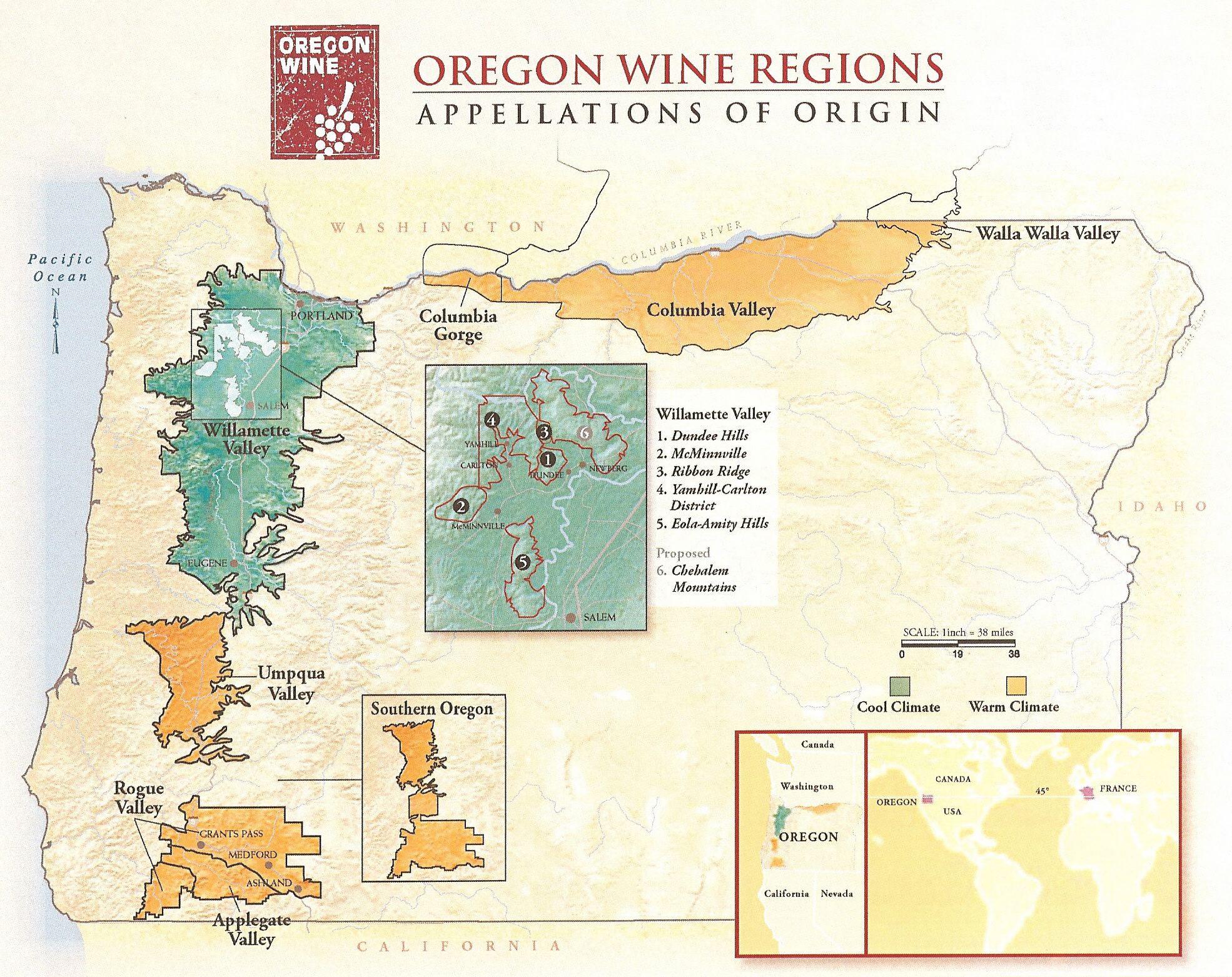 Pinot Noir brought an average price of $2,353 per ton statewide with a low of $1,000 and a high of $5,200. Total tons crushed in Oregon increased 5 percent from 2014 to 73,518, with the North Willamette Valley accounting for 75 percent of the total crush. Pinot Noir production increased to 50,737 tons compared to 45,239 tons in 2014. Case sales increased 9 percent to 3.1 million in 2015 along with an increase in direct-to-consumer sales of 14 percent. Impact Databank report total wine sales as 2.9 million cases on 6% growth in 2015, with Pinot Noir If you drink no Noir, you Pinot Noir Volume 10, Issue 38 September 19, 2016 accounting for 55% of volume. 90% of sales were above $11 a bottle.The largest export market for Oregon wine is Canada (31,015 cases), with Japan second and the United Kingdom third. There are now 702 wineries in Oregon with 468 of them located in the North Willamette Valley. The vast majority of wineries produce fewer than 5,000 cases annually, according to the OWB. The largest producers are King Estate, A to Z Wineworks, Argyle Winery and Sokol Blosser. There is considerable investment by large corporations ongoing including Copper Cane Wines & Provisions, Foley Family Wines, Jackson Family Wines and Ste. Michelle Wine Estates. The French have invested in Oregon as well (see article in the next issue). One significant change in early 2016 was the expansion of the boundaries of the Willamette Valley AVA. 18,560 acres were added after a petition submitted by King Estate Winery, the first boundary change in the AVA since it was first approved in 1983. King Estate Winery’s property line was close to the original AVA line and the winery sources most of its grapes from the Willamette Valley. The Willamette Valley AVA now stretches 120 miles from north to south and 60 miles from east to west and contains six sub-appellations. As you read this, harvest is already underway in the Willamette Valley.
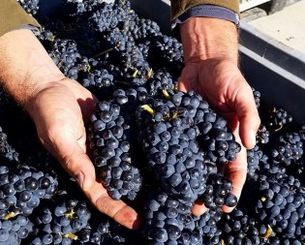 If you are visiting the Willamette Valley, consider the McMinnville Wine Walk. McMinnville’s historic downtown is easy to explore on foot, allowing you to stroll and taste a variety of wines. The charm of McMinnville lies in its historic buildings such as a 1926 power plant that is now home to Elizabeth Chambers Cellar and the red building that once housed the Willamette Valley Walnut Co. where now Walnut City WineWorks is located. Visit all 10 wine tasting rooms, get your booklet stamped along the way and receive a 33 Book Co. tasting notes journal. Visit 15 wine tasting rooms on the map and receive a Wine Walk GoVino wine glass. For information go to www.visitmcminnville.com. Wineries include R. Stuart & Co., Ransom Wines, Terra Vina Wines, Eola Hills Tasting Room, Willamette Valley Vineyards Tasting Room, Naked Winery, Winderlea Vineyard & Winery, Brittan Vineyards, Matello Wines & Goodfellow Family Cellars, Domino IV, Elizabeth Chambers Cellar, The Eyrie Vineyards, Remy Wines, Westrey Wine Company, Walnut City WineWorks, Coleman Vineyards, Coeur De Terre Vineyard, Maysara, Yamhill Valley Vineyards, and Youngberg Hill.
In this issue, Along the Oregon Pinot Trail Part 2, five Willamette Valley wineries are profiled that I visited for the first time in July 2016: Airlie Winery, Alloro Vineyard, Bells Up Winery, Brooks Winery and Knudsen Vineyards.
Airlie WineryThis is a very unpretentious and amiable wine country winery set amongst the foothills of Monmouth, Oregon, twenty miles northwest of Corvallis at the coastal edge of the southern Willamette Valley. The indoor and outdoor modest tasting room is rustic, casual and quintessential Oregon in character, patrolled by two friendly dogs eager to greet arrivals. The hosts when I visited, Mary Olson the owner (pictured below), and Kim Swicker, were easygoing and personable, much like the praiseworthy wines Airlie produces. The estate vineyard, now consisting of 30 acres and named Dunn Forest Vineyard, was originally planted by the previous owners beginning in 1983. They founded Airlie Winery, named after the town name of Airlie that dated to the early 1800s. Mary Olson, who had little experience in wine, but had a passionate interest in it, bought the estate vineyard and winery in 1997. She had worked as a general manager for Northwestern Bell for two years in Oregon and was determined to buy a winery in Oregon. She has since transformed the property into a first class vineyard and winery.
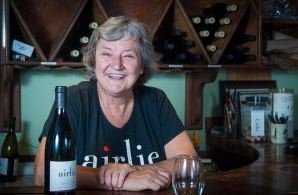 Dunn Forest Vineyard is planted to eight grape varieties and varietal wines are made from each. Airlie also is the exclusive recipient of grapes form the 12-acre BeckenRidge Vineyard in nearby Dallas owned by Denny and Kathy Needham. 65% of the grapes used in Airlie vines come from Dunn Forest vineyard and 45% from BeckenRidge Vineyard. The vineyards are certified sustainable by L.I.V.E. and certified Salmon Safe. Winemaker Elizabeth Clark’s odyssey turned out to be fortuitous for Mary. Elizabeth was a math major with a minor in Russian at Goucher College in Maryland. In 1999, she hitched a ride to Oregon with a friend, knowing that her cousin was living in Portland. She had little interest in wine but spent the summer exploring Oregon. Her interest in wine and its affinity with food blossomed while working for a caterer in McMinnville, leading her to land a job at Amity Vineyards in Amity, Oregon, where she stayed for five years and rose to the position of assistant winemaker. While at Amity Vineyards, Elizabeth attended a wedding at Airlie Winery, fell in love with the people and place, and became the winemaker in 2005. Seven white wines are produced along with Pinot Noir from both Dunn Forest and BeckenRidge vineyards, a Pinot Noir Rosé as well as a Marechal Foch hybrid red wine. The style of wine is similar to Amity Vineyards of the past, with low alcohol levels, high acidity, and welcome food affinities. The wines are very reasonably priced considering the quality and I highly recommend you try them as well as make the effort to visit the winery. The tasting room is open Thursday through Monday from 12:00 p.m. to 5:00 p.m. March through November, or by appointment. Visit www.airliewinery.com.
2015 Airllie Willamette Valley Rosé of Pinot Noir 13.3% alc., pH 3.47, TA 0.61, RS 0.1g/L, $20. Sourced from Dunn Forest and BeckenRidge vineyards. Harvest Bris 22.1º. A blend of two styles of rosé production. One lot was de-stemmed and sat on skins for 3 days, then transferred to neutral oak barrels for fermentation. The second lot was de-stemmed directly into the press and the juice pressed to tank. A slow, cool ferment followed in stainless steel. The wines were blended, cold stabilized and bottled in February 2016. · Both savory herbs and yellow peach, dark cherry and blood orange fruits are combined in a gleaming, dry and refreshing style that has some finishing generosity. Score: 89
2015 Airlie Willamette Valley Pinot Blanc 12.6% alc., pH 3.48, TA 0.60, RS 0.2g/L, 216 cases, $20. Grapes from Dunn Forest Vineyard and BeckenRidge Vineyard. Harvest Brix 21.2º. Grapes were de-stemmed, immediately pressed, settled, racked of lees and inoculated. Cool fermentation in stainless steel for four weeks. · Bright, crisp and refreshing, with aromas and flavors of pear and citrus leading to a dry, thirst quenching finish. Score: 90
2015 Airlie Willamette Valley Pinot Gris 12.3% alc., pH 3.35, TA 0.60, RS 0.2g/L, 915 cases, $18. 60% Dunn Forest Vineyard and 40% BeckenRidge Vineyard. Harvest Brix 21.4º. Grapes de-stemmed, fermented in stainless steel after inoculation with a blend of yeasts. · Discreetly concentrated, with flavors of citrus and white stone fruits, backed by juicy acidity. A lovely food wine. Score: 89
2014 Airlie Seven Willamette Valley White Blend 11.9% alc., pH 3.19, TA 0.67, RS 1.3g/L, 231 cases, $16. A blend of seven grapes in order of most to least: Müller Thurgau, Pinot Gris, Riesling, Gewürztraminer, Chardonnay, Pinot Blanc and Muscat Ottonel. Grapes from Dunn Forest Vineyard. Each grape was fermented separately and then blended. · Reminds me somewhat of Caymus Conundrum. Highly enjoyable, with a pleasing palate of pear, peach, citrus and spice flavors exhibiting the slightest sweetness on the finish. Score: 90
2013 Airlie Willamette Valley Chardonnay $18. Clone 108 grafted over to Dijon 76 in 1991 at Dunn Forest Vineyard. Barrel fermented in mostly neutral French oak barrels and malolactic fermentation. · A charming blend of lemon, tropical fruit, honey and butterscotch aromas and flavors. The wine displays admirable balance and a generous finish that is fueled by good acidity. Score: 91
2013 Airlie Willamette Valley Pinot Noir 12.2% alc., pH 3.44, TA 0.65, 1,046 cases, $28. Sourced from Dunn Forest and BeckenRidge vineyards. Harvest Brix 21.5º. Clones are Pommard, 115, 667 and 777. Grapes 100% de-stemmed, high whole berry content in 1.5-ton fermenters. 3-4 day cold soak, inoculation with variety of yeasts, press and free run wines kept separate. Inoculated for malolactic fermentation and aged 10 months in French oak barrels, 17% new. Bottled unfined and unfiltered. · Moderately light reddish purple color in the glass. Aromas of black cherry and spice lead to a lightly weighted but flavorful wine featuring tastes of red cherry, cranberry and strawberry. Noticeable but not intrusive tannins add structure, and a lively acid backbone stokes vibrancy. Quintessential Oregon in character, and reflective of this vintage. Score: 92
2012 Airlie BeckinRidge Vineyard Willamette Valley Pinot Noir 13.2% alc., $40. · Moderately dark reddish purple color in the glass. Engaging aromas of cherry and spice persist in the glass. Noticeable purpose of attack and finish, featuring lip-smacking flavors of black cherry, black raspberry and spice framed by dry, slightly astringent tannins. Score: 92
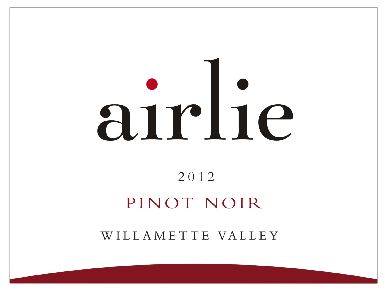
Alloro VineyardAlloro Vineyard is a welcoming Mediterranean-inspired oasis in the Chehalem Mountains featuring an Italian farmhouse, a winery, culinary gardens, chestnut and olive trees, a herd of Hereford cattle, and heirloom sheep that graze the vineyard cover crops. The winery and vineyard are based on sustainable holistic agricultural practices and the intense passion for food of David Nemarnik, the CEO of Pacific Coast Fruit Company, and Alloro’s founder and vineyard manager.
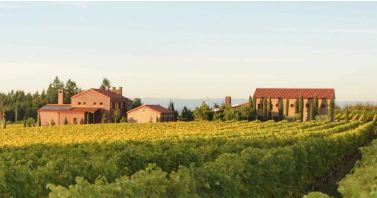 The name, Alloro, is Italian and Latin for “laurel,” reflecting the winery’s location on Laurel Ridge as well as the Laurelwood soils in which the vineyard is established. The name was chosen as well to reflect David’s Italian heritage. Founded in 1999, Alloro Vineyard is a 33-acre single-vineyard, fairly uniform site on 80 acres that has been dry farmed since 2001. It is planted to Pommard and Dijon clones of Pinot Noir and Dijon clones 76 and 96 of Chardonnay. The vineyard is L.I.V.E. certified sustainable and certified Salmon Safe. Because the vineyard is located in the western reaches of the Chehalem Mountains, the summer days linger, leading the wines to develop a more generous fruit profile compared to several other Willamette Valley producers. The winery, designed by architect Larry Ferrar, and specifically constructed for vinifying Pinot Noir, has an underground cellar, and was completed in time for the inaugural 2003 harvest. The winemaker is affable Tom Fitzpatrick, who holds a Master’s Degree in Viticulture & Enology from University of California at Davis. His winemaking career includes stints in Burgundy with Domaine Hubert Lignier in Morey-St-Denis, a small estate winery in Washington State, Hunter’s Wines in New Zealand, and Pine Ridge Winery and Napa Wine Company in Napa Valley. Finally settling in Oregon, he worked as the Associate Winemaker for Hamacher Wines before joining Alloro Vineyard in the spring of 2010. Tom also manages, farms and lives on his own vineyard, Élevée Vineyard, located in the Dundee Hills. Annual production of estate-grown Pinot Noir and Chardonnay is 3,000 cases, including Estate, Justina and Riservata bottlings of Pinot Noir. About 50% of the vineyard production is sold to other premium Williamette Valley producers. The Tasting Room at the winery is open year round Thursday through Monday from 11:00 a.m. to 5:00 p.m.. Private tours of the property can also be arranged through the Tasting Room manager, Nancy Clark at 503-625-1978. Alloro Vineyard was selected as a participant at the International Pinot Noir Celebration in 2010, 2012 and 2014. Visit www.allorovineyard.com. I spent a delightful afternoon at Alloro Vineyard touring the bucolic property and leisurely sampling wine with Tom. We tasted the Estate, Justina and Riservata Pinot Noirs from the 2014 vintage and contrasted them with aged versions of the same wines from the 2010 vintage. As noted above, the because of the location of the vineyard, the Alloro Pinot Noirs are bold, ripe, and richly fruited expressions of Oregon Pinot Noir, yet they retain the charm and balance so desirable in Pinot Noir. The wines are also age worthy as shown by the 2010 vintage wines that were tasted (Tom’s first vintage at Alloro Vineyard). I didn’t score the wines as I was simply enjoying the experience. The 2014 Pinot Noirs will be reviewed formally in the future. The 2013 vintage Pinot Noirs and 2014 vintage Chardonnay were reviewed in the PinotFile in early July 2016: www.princeofpinot.com/ winery/714/.
2012 Élevée Winegrowers Élevée Vineyard Dundee Hills Oregon Pinot Noir 150 cases. From a 5-acre vineyard planted in 1998 in Jory soils owned and farmed by Tom Fitzpatrick. Native yeast fermentation, aged in 25% new French oak barrels. · Moderate cherry red color in the glass. Great Dundee Hills typicality in this wine with soaring aromas of red cherry and baking spices and mid weight flavors of cherry, cranberry accented by earth and iron mineral tastes. Juicy, even slightly tart, with nicely integration oak and some finishing power.
2014 Alloro Vineyard Estate Chehalem Mountains Oregon Pinot Noir 14.1% alc., 1400-1800 cases. This wine is meant to reflect the personality of the site. Aged in French oak barrels, 25%-30% new. · Moderate reddish purple color in the glass. Scents of cherry and spice lead off. The mid weight flavors of black cherry and black raspberry impact the mid palate and carry through the silky and modestly endowed finish. The tannins are folded in and the toasty oak in the background adds spicy seasoning and structure.
2014 Alloro Vineyard Riservata Chehalem Mountains Oregon Pinot Noir 14.2% alc.. Meant to be showier, a little broader and denser with more persistence. Aged in 35%-45% new French oak barrels. · Moderate reddish purple color in the glass. Deep aromas of black cherry and blackberry with a hint of sweet oak. Mid weight plus flavors of black cherry and blackberry are generous and expansive. Soft, smooth and broad in texture with more noticeable but not intrusive oak treatment, and well-integrated tannins. A step up from the Estate in concentration and finishing length.
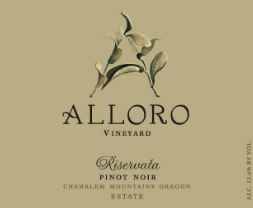
2014 Alloro Vineyard Justina Chehalem Mountains Oregon Pinot Noir 14.3% alc., 300 cases. This wine is even more showier, with the most weight and persistence and the most new oak treatment. It is meant to be aged. · Moderate reddish purple color in the glass. The nose is infused with brooding aromas of dark stone fruits and berries with a slight floral and spice accent. Slightly darker fruited in a full bodied, flamboyant style, with more toast overlay, and a very long and hedonistic finish.
The 2010 vintage offered a marked contrast to the warm 2014 vintage. 2010 was a much cooler year, with extended hang time and a significantly later harvest.
2010 Alloro Vineyard Estate Chehalem Mountains Oregon Pinot Noir Moderate reddish purple color in the glass. Aromas of black cherry, spice, leather, tobacco leaf and raisin. Tertiary characters of tea, rose and tobacco leaf show up on the palate. The tannins have melded and the juicy, long finish satisfies. This wine has aged beautifully.
2010 Alloro Vineyard Riservata Chehalem Mountains Oregon Pinot Noir Moderate cherry red color in the glass. Aromas and flavors of cherry, pomegranate, tea leaf and spice are framed by fully integrated tannins. Compared to the Estate, the finish is noticeably more generous, spicy and persistent.
2010 Alloro Vineyard Justina Chehalem Mountains Oregon Pinot Noir Moderate reddish purple color in the glass. Soaring aromas of cherry, spice and rose petal become intoxicating in the glass over time. A stunning wine with mid weight plus flavors of blackberry and black raspberry with a hint of tea leaf. More natural acidity and less fruit concentration than the 2014 vintage, but highly enjoyable in its own right. The age ability of this bottling is well demonstrated as this wine can easily shine for another 5-10 years.
Bells Up WineryBells Up Winery is a very small boutique producer of Oregon Pinot Noir, Pinot Blanc, and Washington Syrah located in the Chehalem Mountains. David and Sara Pearson Specter were inspired to open a winery in the Willamette Valley after a vacation at Chehalem Ridge Bed & Breakfast in Newberg in 2008. David began to pursue winemaking as a hobby shortly thereafter, eventually pursuing professional winemaking through a wine apprenticeship at an urban winery in Cincinnati, Ohio, and winning awards at national amateur winemaking competitions. David moved his family to Oregon in the summer of 2012, and together with Sara, acquired a suitable 10-acre site and directed construction of a small winery and tasting room in a former barn on the property. They cleared a south facing hillside on the property and planted 3 acres of Pommard and 667 Pinot Noir clones in 2014, Willamette Valley’s first planting of Syval Blanc in 2015, and 2.5 acres of 113, 943 and Wädenswil Pinot Noir clones in 2016. The winery was established in 2013 and the first wines were released on Memorial Day 2015. The name “Bells Up” comes from David’s French horn playing, with bells up referring to a dramatic moment in classical music where the composer instructs French horn players to lift the bells of their instruments up and project sound with maximum intensity. David played the French horn throughout high school and college, and the winery is his “Bells Up” moment. The Specter’s inspiration for their winery model comes from their nearby mentors at Privé Vineyard, a small winery I have visited several times and one of some renown. The 2014 and 2015 vintage wines were produced from sourced fruit. Production is 400 cases annually. The wines are sold through a mailing list and the tasting room that is open by appointment. The tasting room is adjacent Medici Vineyard. Visit www.bellsupwinery.com.
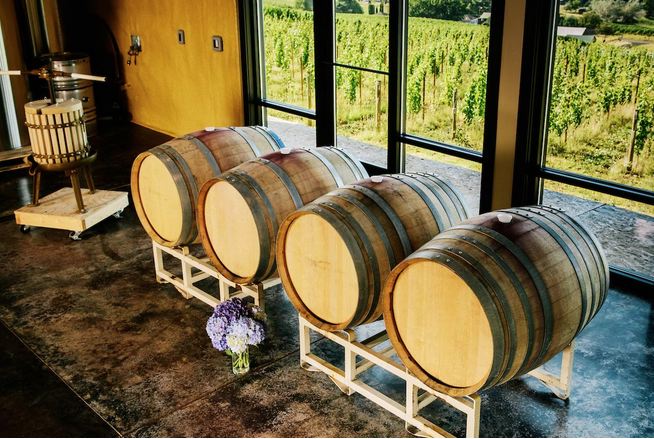
2015 Bells Up Prelude Willamette Valley Oregon Rosé of Pinot Noir 12.9% alc., 65 cases, $18. 15-year-old, non irrigated vines, clones 777 and 115. Exposed to skins for 24 hours, then pressed before fermentation. Fermented in stainless steel and aged in neutral oak. · Light pinkish orange color in the glass. Aromas of ripe strawberries, brown spices and orange zest. Pure flavors of blood orange, strawberry and spice. Nicely balanced and easy going. Score: 88
2014 Bells Up Rhapsody Willamette Valley Oregon Pinot Blanc 12.8% alc., 116 cases, $22. Aged on the lees in stainless steel tanks for 6 months. No malolactic fermentation. · Light greenish-yellow color in the glass. Aromas and flavors of apple, citrus and pear in a clean and fresh style, with a savory bent and a riff of aciddriven salinity. Score: 86
2014 Titan Willamette Valley Oregon Pinot Noir 12.5% alc., pH 3.68, TA 0.59, 128 cases, $40. Fall release. 24% Pommard (25-years-old), 38% 115 (15-years-old), and 38% 777 (15-years-old). Both Jory and Willakenzie soils. 100% de-stemmed, aged 10 months in French oak barrels, 35% new. · Light reddish purple color in the glass. Decanted before tasting, but still shy, offering aromas and flavors of dark cherry, plum, spice and toast. Well-balanced, with a modest but satisfying finish. Score: 89-90
2014 Bells Up Villanelle Tonnelier Vineyard Reserve Yamhill-Carlton Oregon Pinot Noir 13.6% alc., 53 cases, $54. A barrel selection. From a 3.5-acre vineyard on sedimentary Willakenzie soil. Equal parts free run clones 115 and 777 (15-year-old vines) aged 10 months in French oak barrels, 45% new. · Light reddish purple color in the glass. Inviting complexity in this wine sporting aromas of black cherry, dark raspberry, spice and tobacco, and flavors of black cherry, orange pekoe tea and spice. Plenty of fruit driven power to please, but easy to cozy up to with suede-like tannins and an energetic finish. Score: 90-91
2013 Titan Willamette Valley Oregon Pinot Noir 12.5% alc., pH 3.77, TA 0.60, 163 cases, $40. 34% Pommard clone from Chehalem Mountains and 33% each clones 115 and 777 from Yamhill-Carlton. Both vineyards are planted in Willakenzie soil. Grapes picked after September rains. Aged 11 months in 40% new and 60% neutral French oak barrels. · Light reddish purple color in the glass. Earth-kissed aromas of cherry and orange pekoe tea. Elegant, with a “crunchy” texture, featuring cherry and spiced plum flavors, and a juicy finish. Score: 89
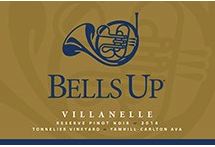
Brooks WineryThis iconic Oregon winery has been on my must-visit bucket list for some time. Luckily, Janie Brooks was in town and she, along with winemaker Chris Williams, met me at the hospitality center and winery in the Amity- Eola Hills that overlooks the Cascade Range and the Willamette Valley floor. The facility is impressive, with multiple sitting areas both indoors and outdoors to enjoy Brooks wines along with appropriate food matches prepared by a chef on site. (All photos courtesy of Andrea Johnson Photography)
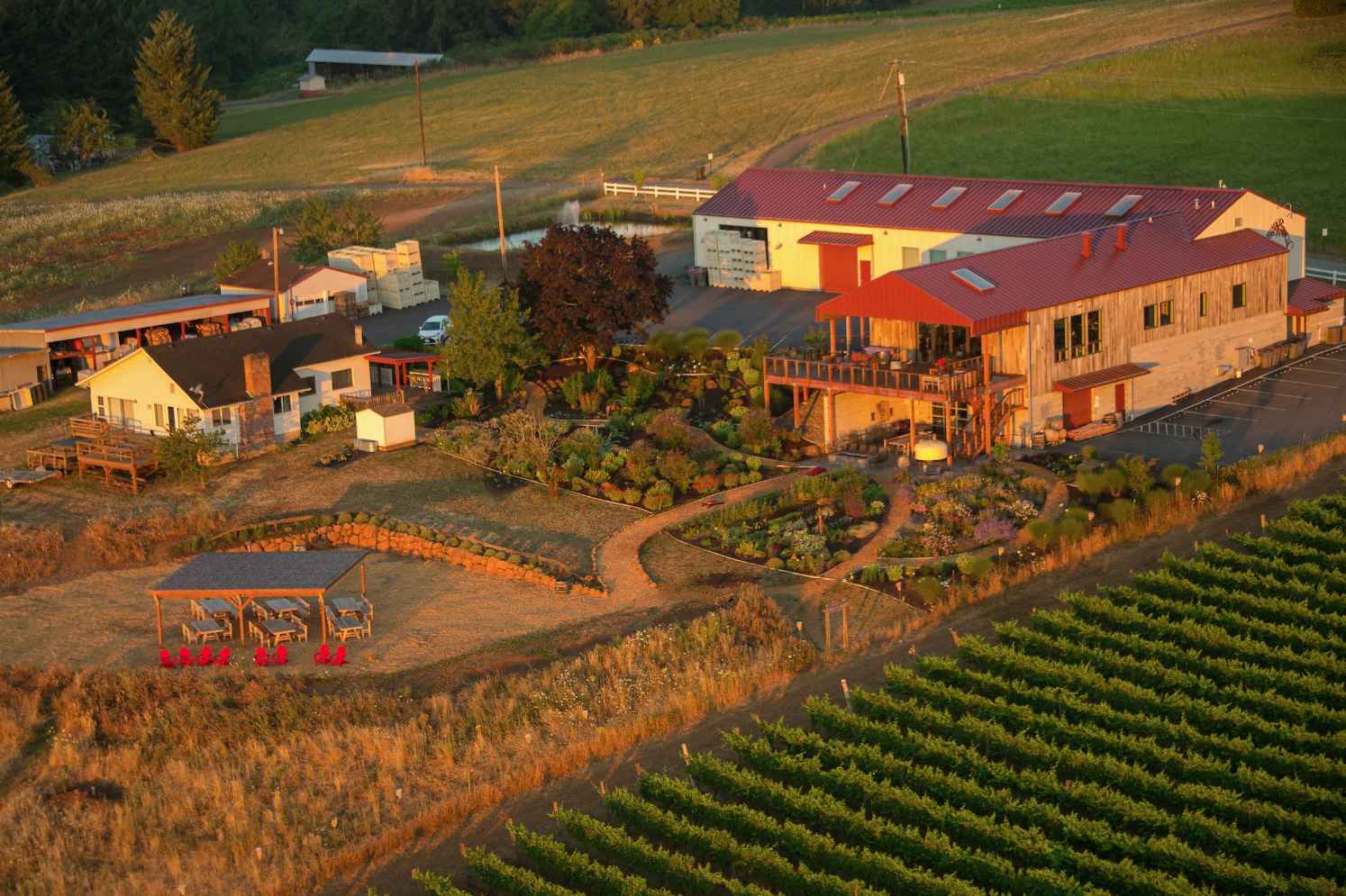
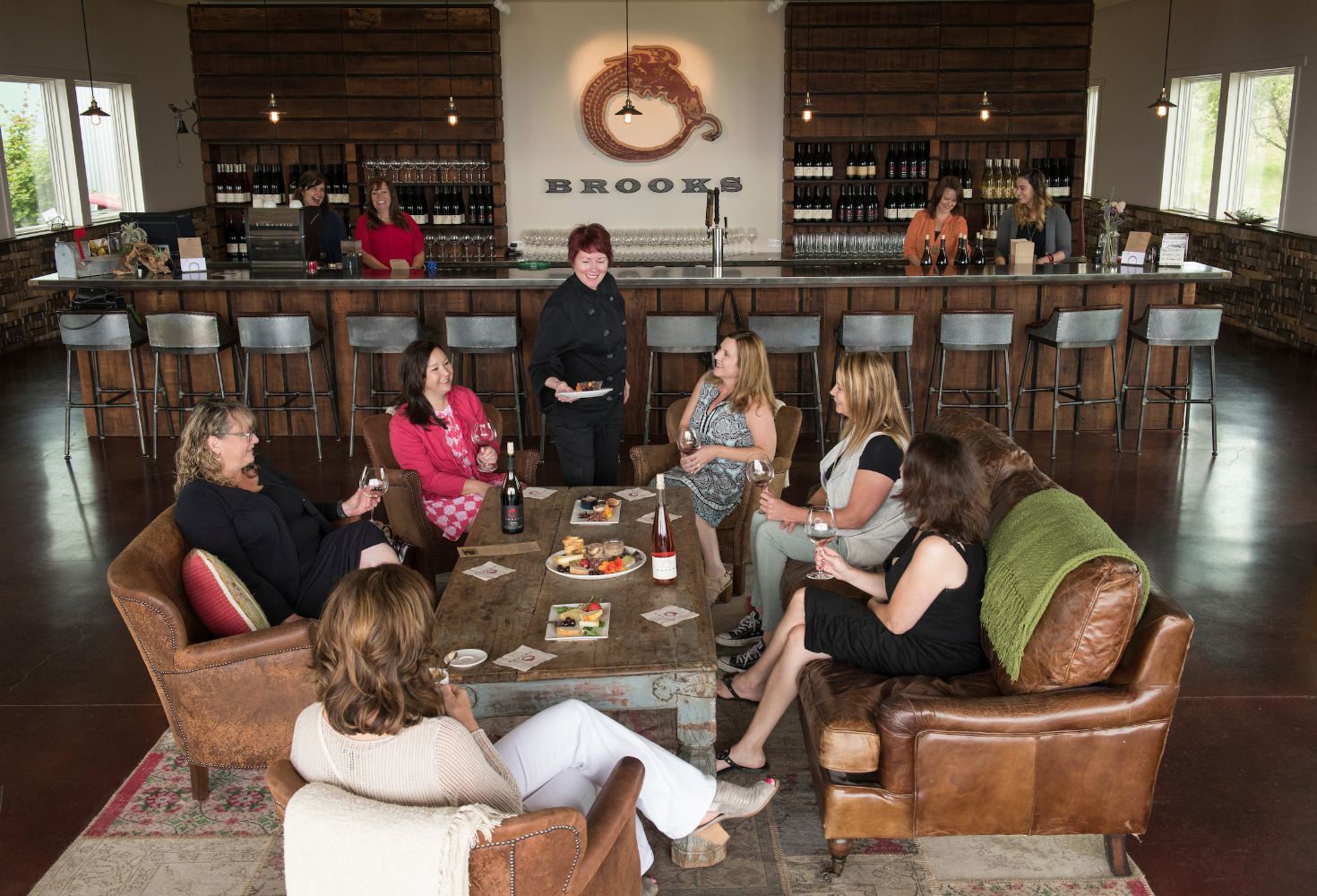
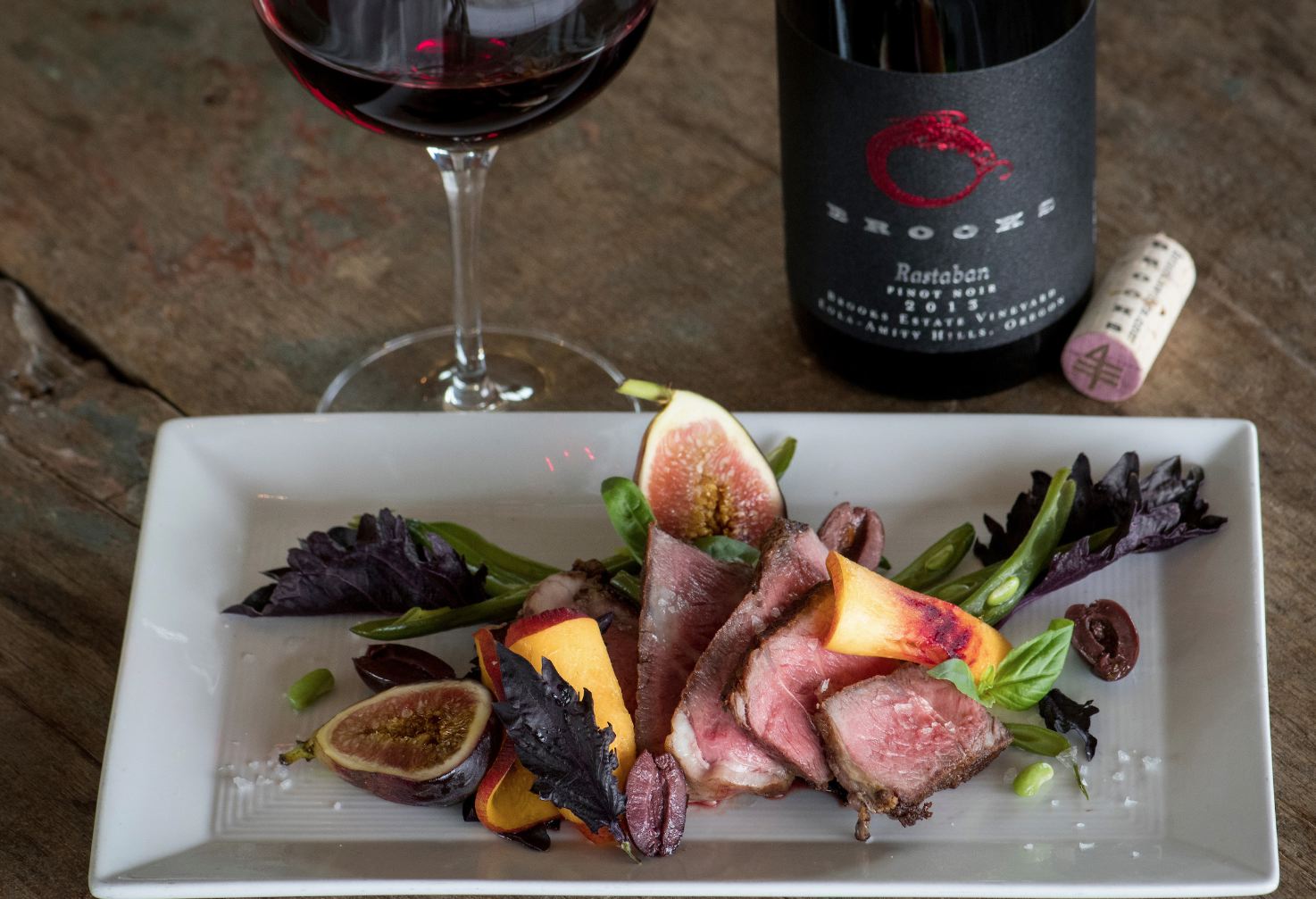 The history of Brooks Winery is well known to pinotphiles. The founder, winemaker Jimi Brooks, was highly respected by his Oregon colleagues for his devotion to holistic farming and winemaking in the Willamette Valley. He started Brooks Winery in 1998 after winemaking stints at Maysara and WillaKenzie Estate wineries, but tragically passed away six years later at the relatively young age of 38 years. The winery was bequeathed to Jimi’s only child, Pascal, who was eight years old when his father died, making him the youngest winery owner in the world. After Jimi’s death, a consortium of winemakers from the Willamette Valley kept the winery productive until winemaker Chris Williams, Jimi’s former assistant winemaker, who had worked along side Jimi at Maysara, WillaKenzie Estate and Brooks Winery, took over in 2005. He was able to bring continuity to Brooks wines since he shared Jimi’s philosophy and has remained the winemaker to this day. Janie Brooks Heuck, Jimi’s sister, now manages the winery, turning it into a family legacy. Since becoming Managing Director in 2004, she increased production from 3,500 to 20,000-25,000 cases annually.
 In 2009, a 20-acre vineyard was acquired in the Eola-Amity Hills that Jimi had farmed biodynamically since 2002, and Demeter Biodynamic certification followed in 2012. The site was originally planted between 1973 and 1977 to Pinot Noir and Riesling. 10 acres of own-rooted vines remain on this aged vineyard that is now named Brooks Estate Vineyard. 2014 was a bright hallmark for the winery, as the new winery and tasting room opened, and the winery was the focus of a feature length documentary titled, ‘American Wine Story,’ that was shown at multiple film festivals in 2014 and is available at www.americanwinestory.vhx.tv/. The logo or symbol on the label of Brooks wines was created by founder Jimi Brooks and represents the cycle of life and rebirth. Brooks Winery was named one of five “Must Visit Wineries” by USA Today and I can see why. The wines are all excellent and the hospitality is unriviled. Tasting is available daily from 11:00 a.m. to 5:00 p.m. with different tasting options and food pairings available. Along with the Wine Bar, craft beer is available on tap so that all visitors can indulge their preferences. Visit www.brookswine.com. Currently, Brooks specializes in Pinot Noir and Riesling, with several other white aromatic varietals also available. 17 different Rieslings are offered, sourced from 14 different vineyards. Multiple Pinot Noirs are produced from estate and sourced fruit including a Rosé. All Pinot Noir wines undergo 100% de-stemming, followed by a 5 to 7-day cold soak, and a subsequent native yeast fermentation kept cool to avoid over extraction especially in warm vintages. Use of new oak is very modest. The wines are bottled after cross-flow filtration. After a tour of the winery, I settled in with Janie and Chris in a private tasting room that is available for special tasting experiences and the trade. It has an unusual wall of cork tiles and is highly suitable for wine sampling. The first wines reviewed were tasted at the winery and the subsequent wines were evaluated at home in my usual fashion.
Winery Tasting:
2015 Brooks Runaway Red Willamette Valley Pinot Noir 13.6% alc., 4,300 cases, $23. A blend of ten vineyards and a barrel selection. 100% de-stemmed, native yeast fermentation, aged 10 months in French oak barrels. Tasted at the winery. · Moderately light reddish purple color in the glass. A highly approachable wine with uplifting aromas of cherry and peppery spices. Soft and suave in the mouth with flavors of cherry, cranberry and spice, finishing with modest intensity. Score: 88
2014 Brooks Big Cheese Vineyard Eola-Amity Hills Oregon Pinot Noir 14.50% alc., pH 3.60, TA 0.52, 100 cases, $48. 50% Pommard and 50% 777 clones, ten-year-old vines. Aged 18 months in French oak barrels. · Moderate reddish purple color in the glass. The nose leads with fruity plum, blackberry and boysenberry aromas as well as lesser noted nutty oak and savory forest floor aromas. Fruit forward and ripe, featuring flavors of purple grape, black cherry and boysenberry in a mid weight styled wine with complimentary oak in the background and some finishing length. Score: 89
2013 Brooks Terue Wines York Hill Vineyard Columbia Gorge Oregon Pinot Noir 12.2% alc., $48. A second label for wines from outside the Willamette Valley. · Light reddish purple color in the glass. Very elegant, with aromas and flavors of cherry, blueberry, Damsel plum and spice. Gentle tannins, good vibrancy, and a pleasing, but short finish. Score: 88
2013 Brooks Rastaban Willamette Valley Oregon Pinot Noir 12.0% alc., pH 3.61, TA 0.59, 300 cases, $55. Rastaban is a star, the eye of the dragon in the constellation Draco. A barrel selection first produced in 2003 from Momtazi Vineyard. This wine is composed of Pommard, 115 and 777 clones from the Brooks Estate Vineyard that has some of the oldest, biodynamically farmed vines in the Willamette Valley. A consistent elegant style of wine vinified with small amount of new oak - 20% in this vintage, and often the best effort of the vintage. Aged 18 months in French oak barrels. · Moderately light reddish purple color in the glass. The promising aromas of cherry, black plum, spice and forest floor entice. Light to mid weight in style and reflective of the vintage, with a pleasing charge of red and purple fruits accented with cardamom spice and Italian herbs. Very juicy, with fine grain tannins and a finish that warms the soul. Score: 92-93
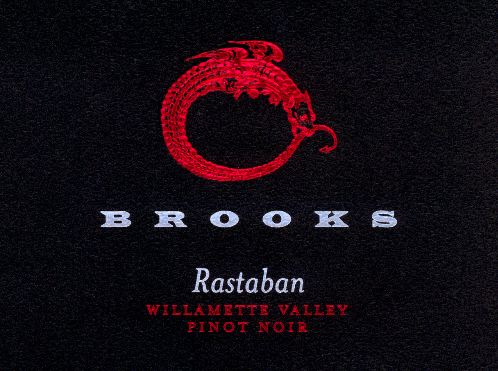 The Janus bottlings have a core of fruit from the Brooks Estate Vineyard combined with primarily grapes from Eola-Amity Hills vineyards. A mini vertical was tasted to show vintage differences yet a consistent style. Janus is the winery’s flagship Pinot Noir and is the richest and most intense blend offered in honor of Jimi’s legacy of crafting expressive blends. Janus was a Roman mythological God depicted with two faces looking to both the future and the past.
2012 Brooks Janus Willamette Valley Oregon Pinot Noir Moderate crimson color in the glass. The savory nose offers scents of compost and mushroom with subtle notes of wild berries. Elegantly composed, with a middleweight core of earth-kissed plum and marionberry flavors backed by juicy acidity. There is noticeable staying power on the glorious finish. Score: 93
2010 Brooks Janus Willamette Valley Oregon Pinot Noir 12.2% alc.. · Moderately light reddish purple color in the glass. Redder fruits such as cherry and cranberry are featured along with notes of sandalwood, tea leaf, and a hint of mushroom. Rather delicate and light in weight, with some oak inlay and dry tannins on the finish. Score: 90
2009 Brooks Janus Willamette Valley Oregon Pinot Noir 13.8% alc.. · Moderately light reddish purple color in the glass. Ripe purple berry and stone fruits blend with savory notes of mushroom and herbs on the nose. Nicely composed, with ripe, but not overripe flavors of black plum and boysenberry with a hint of spice. The tannins are submerged and the finish has staying power. Score: 92
2007 Brooks Janus Willamette Valley Oregon Pinot Noir Moderately light reddish purple color in the glass. Intoxicating aromas of cherry, wilted rose and potpourri lead to a lightly weighted and elegant wine that is more savory than fruity with flavors of tea leaf, herbs, tobacco, smoke alongside light red fruits, finishing with a dry, slightly grippy finish. Score: 89
I rarely review or even drink domestic Riesling. Chris initially offered me a couple of Brooks Rieslings to sample and I was hooked. He ended up sharing six different Rieslings with me, all superb. My notes are not extensive but you get the idea. A Terue Wines Muscat and Brooks Gewüztraminer were also excellent. I realized there is a serious commitment to Riesling at Brooks and the quality of the wines reflect this goal. The degree of dryness of each Riesling is depicted on the back label.

2014 Brooks Ara Willamette Valley Oregon Riesling 13.8% alc., pH 3.00, TA 0.92, RS 12.9 g/L, 300 cases, $28. 50% estate fruit. Dry. · Scents of flint, petrol, ripe apple and peach on the nose, and enticing flavors of apple and pear on the palate in this crisp, refreshing wine
2015 Brooks Bois Joli Vineyard Eola-Amity Hills Oregon Riesling 12.5% alc., pH 3.00, TA 0.86, RS 31.7 g/L, 300 cases, $24. A medium dry offering. Vineyard planted at 720 feet elevation in marine sedimentary soil. Sent straight to press and fermented in stainless steel. Cross-flow filtered. · Terrific in every way, featuring a core of white peach, apricot and pear fruits that soar on the nose and palate. Good concentration, and lively acidity, with a glorious peach-driven finish.
2015 Brooks Sweet P Eola Amity Hills Oregon Riesling 11.6% alc., pH 3.01, TA 0.81, 600 cases, RS 39.7 g/L, $24. 100% estate grapes. Medium dry. · Very clean aromatic profile, featuring scents of stony fruits, white flowers and mineral. Admirable acid and sugar balance with a juicy thread of white peach, apricot and tropical fruits spearheading the pleasure. The wine finishes with a cleansing burst of acidity. Sweet P is for me.
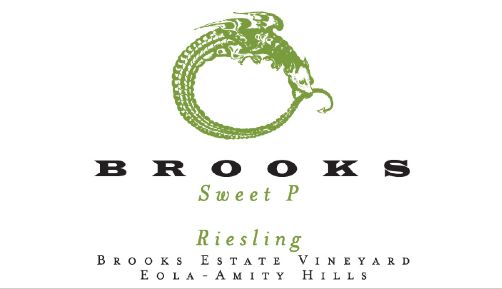
2014 Brooks Le Chenaie Vineyard Eola-Amity Hills Oregon Riesling $24. Moderately sweet. · This wine is infused with mineral and petrol notes typical of great Riesling. The crisp texture delights as does the citrusinfused finish of noticeable persistence.
2014 Brooks Orchards Fold Vineyard Eola-Amity Hills Oregon Riesling 12.9% alc., $24. Dry. · Aromas of petrol, petrichor and citrus. More austere, similar to sucking on a lemon peel, with a tight, dry finish.
2014 Brooks Tethys Late Harvest Willamette Valley Oregon Riesling 11.5% alc., pH 3.14, TA 0.94, RS 140 g/L, 375 cases, $25. · Very pleasurable and not at all cloying or overtly sweet with flavors of fig, yellow raisins, honey and nuts. Spirited acidity keeps the wine buoyant and lively.
Comprehensive tasting of other wines at home:
2015 Brooks Willamette Valley Oregon Pinot Noir Rosé 14.2%, pH 3.37, TA 0.58, RS 1.4 g/L, 1,000 cases, $18 (sold out). 54% Muska, 30% Crannell and 16% B&J vineyards. 54% straight to press, 46% cold soaked for 6 hours. Fermented in stainless steel. · Moderate salmon color in the glass. Nicely perfumed with scents of strawberry, blood orange and yellow apple. Crisp in the mouth, with flavors of strawberry, cherry Sunburst candy, blood orange and watermelon, an added hint of herbs, finishing with a good cut of acidity on the thoroughly dry finish. Score: 90
2014 Brooks Willamette Valley Pinot Noir 13.0% alc., 3,800 cases, $28. A blend of multiple vineyards. 100% de-stemmed, native fermentation, aged 10 months in French oak barrels, bottled after cross-flow filtration. · Moderate reddish purple color in the glass. Aromas of black cherry pie, spice, floral bouquet and a slight straw note lead off. Light to mid weight flavors of black cherry and darker cranberry are infused with good acidity and backed by suave tannins. Forward drinking, with appropriate oak input and a modest finish. Score: 88
2014 Brooks La Chenaie Vineyard Willamette Valley Pinot Noir 13.2% alc., pH 3.41, TA 0.60, 75 cases, $48. Vineyard planted in 2006 at 485 feet elevation in ancient volcanic soils. Wädenswil clone. Aged 18 months in French oak barrels. Cross-flow filtered. · Moderately light reddish purple color in the glass. Enticing aromas of cherry, Asian spices, earthy flora and a touch of oak. Silky, elegant and reserved initially, showing more mid palate expression and finish over time in the glass. The wine’s light to mid weight flavors of dark red cherry, cranberry, raspberry and plum are infused with racy acidity that is most evident on the lip-smacking and hi-pitched, citrus-driven finish. Score: 91
2014 Brooks Temperance Hill Vineyard Eola-Amity Hills Oregon Pinot Noir 13.3% alc., pH 3.69, TA 0.51, 250 cases, $48. A legacy vineyard planted in 1981 at 675 feet elevation in volcanic basalt. Vineyard farmed sustainably and organically by Dai Crisp since 1999. 40% 777, 31% Pommard and 29% Wädenswil clones. Aged 18 months in French oak barrels. Cross-flow filtration. · Moderately light reddish purple color in the glass. The nose draws you into the glass with uplifting scents of crushed dark cherries, blackberry jam, earthy flora, herbs and vanilla. Very silky in the mouth, with a complex flavor profile of black cherry, blackberry, root vegetables, earth and mushrooms. Plenty of sap to satisfy, yet with an elegant demeanor, and exceptional length on the finish. Score: 93
2014 Brooks Crannell Vineyard Eola-Amity Hills Oregon Pinot Noir 13.5% alc., pH 3.45, TA 0.60, 300 cases, $48. Vineyard planted in 1984 at 550 feet elevation in volcanic basalt soil. 75% 115 and 25% Pommard. Aged 18 months in French oak barrels. Cross-flow filtered. · Moderately light reddish purple color in the glass. Aromas of dark red cherries and berries and rose petal arrive over time in the glass. Light to mid weight in style, with a charge of black cherry and raspberry fruits underlain with a touch of smoky oak. Nicely composed and easy to like, with a welcome surge of uplifting acidity on the finish. Score: 90
2014 Brooks Janus Willamette Valley Oregon Pinot Noir 13.8% alc., pH 3.64, TA 0.54, 1,500 cases, $38. 58% Brooks Estate Vineyard with contributions from several other vineyards in the Willamette Valley, primarily Eola-Amity Hills. Aged 18 months in French oak barrels. Cross-flow filtered. · Moderate reddish purple color in the glass. A mix of red and black berry, spice and forest floor aromas rise from the glass. A hint of volatile acidity quickly blows off. Thoroughly seductive in the mouth, with luscious flavors of black cherry, dark red berry and plum. The fruit goodness seems to build over time and the wine achieves progressive goodness the more one tastes it. Highly flavorful, yet gracious in character, with a substantial tannic backbone that ensures age ability, and a delightful finish offering both intensity of fruit flavor and valued grip. Score: 93
Knudsen VineyardsI have been following Knudsen Vineyards (pronounced Kuh-NUDE-sen) wines since the beginning in 2013, but had not visited the vineyard or met with Page Knudsen Cowles, who along with two of her three brothers, are carrying on the legacy of Cal Knudsen. The Knudsen Vineyards story and reviews of the winery’s Pinot Noir and Chardonnay have been featured in past issues of the PinotFile: www.princeofpinot.com/article/1586/ and www.princeofpinot.com/article/1663/. To summarize briefly, C. Calvert “Cal” Knudson was a Weyerhaeuser timber products executive with a dream of growing grapes and making wine. In 1971, he and his spouse Julia Lee bought a 200-acre walnut orchard in the Dundee Hills. He was convinced that the North Willamette Valley could produce still and sparkling wines of equal quality to the great wines of Burgundy and Champagne. When Cal planted 30 acres of vines in 1972, the vineyard became one of the largest in the Willamette Valley and by 1975, when nearly 60 acres had been established, it was among the largest vineyards in Oregon. In 1975, Cal and Oregon wine pioneer Dick Erath formed Knudsen-Erath Winery, becoming the first commercial winery in the Dundee Hills. Knudsen-Erath Winery produced Pinot Noir, Chardonnay, Riesling and sparkling wines and became one of the largest wineries in Oregon. The Knudsen Erath partnership would dissolve amicably in 1987, so Cal invested in Argyle Winery and supplied Argyle Winery with grapes. Cal was a sparkling wine enthusiast and Argyle had begun to make Oregon’s top lineup of sparkling wines under the direction of winemaker Rollin Soles. Knudsen Vineyards has remained a primary supplier of grapes to Argyle, which has grown to become one of the larger wineries in Oregon. Knudsen Vineyards has also supplied grapes to other renowned producers of still and sparkling wines in Oregon. Cal passed away in 2009. Cal and Julia Lee’s four adult children now own Knudsen Vineyards and have invested significantly in replanting and other enhancements to this historically significant vineyard. Knudsen Vineyard now consists of 130 planted acres of primarily Pinot Noir (73%) and Chardonnay (24%), with a mix of old vines and newer, high-density blocks planted to Dijon clones. They launched the Knudsen Vineyards winery with the release of 100 cases of Pinot Noir from the 2012 vintage. 100 cases of Chardonnay followed the next year.
 I met Page at the quaint cabin located at the top of Knudsen Vineyard. We took a driving tour of the vineyard and then tasted some Knudsen Vineyard wines at the cabin. She is a Yale graduate with an MBA from Harvard, and lives in Minneapolis, but manages the marketing and sales of the winery through frequent visits to Oregon. She meets regularly with her brothers to formulate business plans.
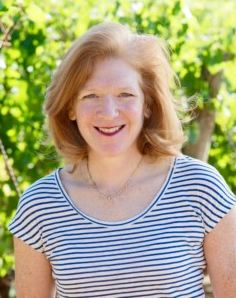 She explained that the Knudsen Vineyards Pinot Noir and Chardonnay are vinified at Argyle Winery by current winemaker Nate Klosterman, Soles’ protégé. Production has been increased to a projected 1125 cases in 2016. The nearby Erath winery and tasting room is on Knudsen property and the lease expires in 2018. The old winery is no longer viable. Page said that there are plans to establish a tasting room at some point but it is uncertain if the Erath facility will be used. The 2014 Knudsen Vineyards Dundee Hills Oregon Pinot Noir was released in August. Mailing list members get first crack at buying the Knudsen Vineyards wines. Visit www.knudsenvineyards.com. Tours of the vineyard and tasting is available by appointment.
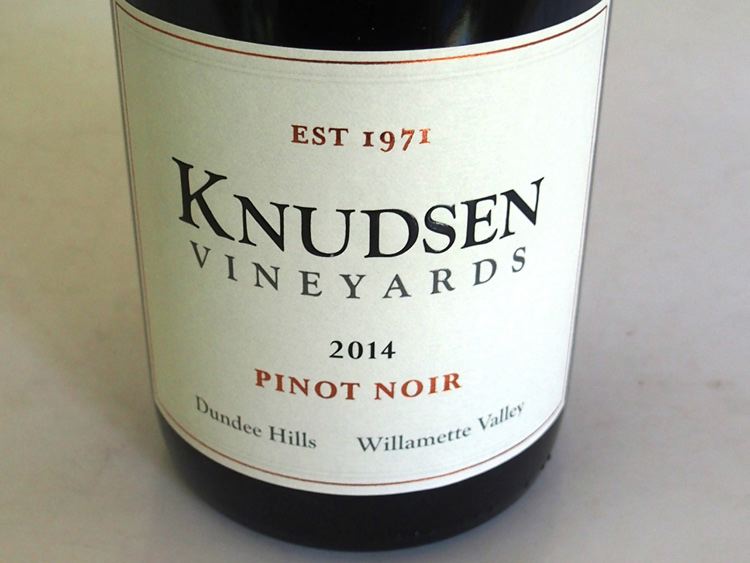 2014 Knudsen Vineyards Dundee Hills Willamette Valley Pinot Noir 14.1% alc., pH 3.65, TA 0.52, 560 cases, $55, screwcap. Clones 667, 777 and 115 planted in 1994-2004 in Jory soil at 570 to 810 feet elevation. Aged 15 months in French oak barrels, 25% new. · Moderately light reddish purple color in the glass. A very gracious wine with vibrant aromas of cherry compote, Asian spice and a hint of graham. On the palate, there is impressive purity of dark cherry and blueberry fruit flavors with a savory thread in the background. The interplay of fruit and savory elements give the wine a special credence. The tannins are suave, the oak is deftly integrated, the thirst-quenching, lengthy finish is fueled with vivid, tangy cherry goodness. Score: 93
Amalie Robert EstateThis is one of the Willamette Valley’s most distinguished wineries, but not one that is widely known except among the Pinot Noir cognoscenti. You won’t hear its name mentioned in the same breath with the more renowned Oregon winery names such as Ponzi, Argyle, Domaine Drouhin and Cristom, yet it belongs in that echelon. After tasting several releases sent to me recently for review, I wish I had visited this winery when I was traveling along the Pinot trail in July. I met proprietor Ernie Pink once at Pinot Days a few years ago and did a podcast that is still posted on Grape Radio: www.graperadio.com/archives/tag/pinot-days/. I left the podcast thinking, “This is a smart guy with a gleaming smile.” Ernie and Dena Drews bought a 60-acre cherry orchard from a retiring farmer, located 15 miles south of Salem and just outside of Dallas, Oregon, in 1999, and converted it into a vineyard property. The couple had careers in the computer industry, and quickly learned about viticulture and winemaking through a local community college. Literally, viticulture and winemaking became their second careers. They may have been wine neophytes, but they knew what they were doing when they established their vineyard adjacent the famed Freedom Hill Vineyard. The 34-acre dry-farmed vineyard was planted primarily to Pinot Noir, with lesser amounts of Pinot Meunier, Syrah, Chardonnay and Viognier. The first vintage in 2002 was sold to other notable Willamette Valley wineries including Cristom Vineyards, Elk Cove Vineyards and Panther Creek. By 2006, a multilevel, gravity-flow winery had been built and the first vintage under the Amalie Robert label was released. Only estate grown fruit has been used in Amalie Robert Estate wines. The wines are grown, fermented, blended and bottled at the estate.
The estate vineyard is dry farmed with proper soil moisture management to allow enough hang time to achieve full ripeness in every vintage. Very few leaves are pulled to allow for shading of clusters and prevent harsh tannins of overexposure of grapes.
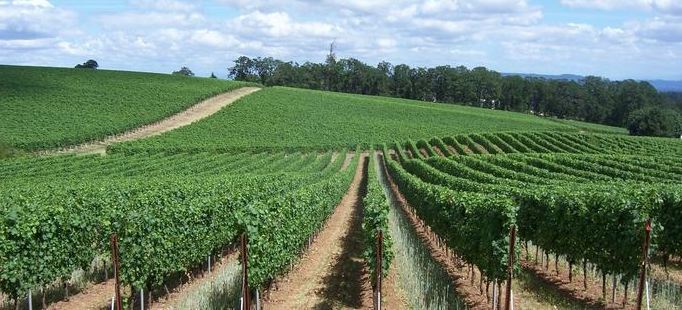 The name, Amalie Robert, is a combination of Dena’s middle name Amalie (“AIM-a-lee”) and Ernie’s middle name Robert. The Amalie Robert Pinot Noirs are close to heart because they are crafted with whole clusters, feral yeast and barrel and bottle aged as necessary for complexity and drink ability upon release. The wines are bottled unfined and unfiltered. The portfolio of Pinot Noirs includes seven different wines. In 2012, Ernie was in it to win it! Ernie’s blog, “The FLOG,” at www.amalierobert.blogspot.com, follows each vintage year with insightful comments and is something I read regularly. Tours and tasting are available by appointment. Visit the website at www.amalierobert.com. On the website there are no technical descriptions of the wines, but the wine descriptions are informative and often humorous. One must search carefully to buy wines on the website: look for “Amalie Robert Direct - Buy Now” in the upper right corner. Wines dating back to the 2007 vintage are available on the website. Pinot Noir from the excellent 2012 vintage such as those reviewed here are currently hard to find, as Oregon wineries are now releasing the 2014 vintage.
2012 Amalie Robert Estate iPinot Willamette Valley Oregon Pinot Noir 13.3% alc., 300 cases, $28. iPinot is composed of reserve quality barrels of wine selected for the luxury tier of Pinot Noirs blended to create a reserve level wine without the reserve level price. After Amalie’s Cuvée and the Estate Selection are determined, this wine is made from a few favorite barrels of wine without homes. Whole cluster inclusion and feral yeast fermentation. · Moderate reddish purple color in the glass. The nose is very earthy, with aromas of mulch and mushroom, and subservient black cherry fruit in the background. Light to mid weight flavors of cherry and red berry are robed in ripe tannins. The wine has enviable harmony and a cherry-fueled finish that has good intensity. Score: 90
2012 Amalie Robert Estate Estate Selection Willamette Valley Oregon Pinot Noir 13.6% alc., 295 cases, $50. Ernie’s barrel selection meant to reflect the vineyard and his palate. Each block in the vineyard is fermented with whole clusters in small 1.5-ton lots and aged 18 months in French oak barrels. · Moderately dark reddish purple color in the glass. Welcoming aromas of black cherry, rose petal, mushroom and pine sap lead to a middleweight styled wine with attacking flavors of black cherry and raspberry. The fine grain tannins are well proportioned, their is seasoned oak in the background, and the wine finishes with a juicy and admirably long finish. Score: 92
2012 Amalie Robert Estate Amalie’s Cuvée Willamette Valley Oregon Pinot Noir 13.6% alc., 295 cases, $50. This wine is a barrel selection by Dena that reflects her palate and the site, and is meant to be approachable upon release. · Moderate reddish purple color in the glass. The aromas of cherry, rose petal and spice are so enthralling, I was in no hurry to taste the wine. Very seductive, with a core of fresh black cherry, black raspberry and blueberry fruit flavors that saturate the mid palate and return in waves on the extraordinarily long finish. The wine is beautifully crafted with a supportive tannic spine and balancing acidity, but it is the finish that separates this wine from the pack. Score: 94
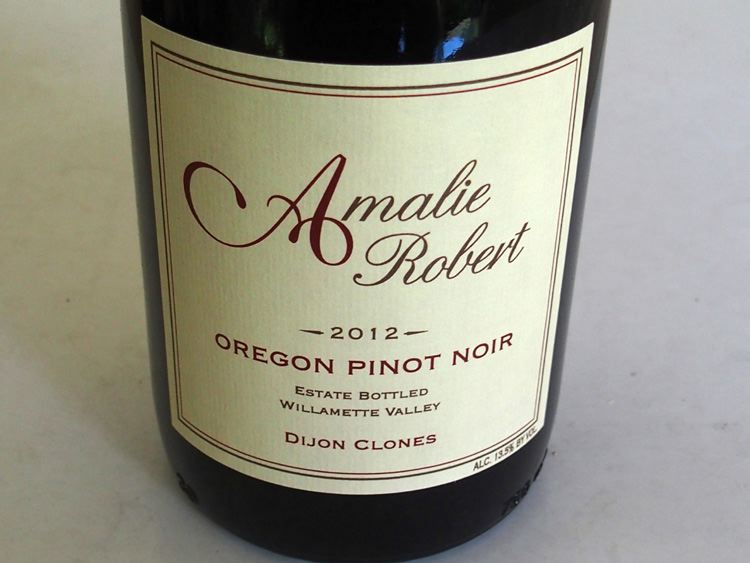 2012 Amalie Robert Estate Dijon Clones Willamette Valley Oregon Pinot Noir 13.5% alc, 1,030 cases, $40. 100% estate grown and bottled. A collage of seven Dijon clones from twelve dry farmed vineyard blocks. The individual blocks were fermented with whole clusters and feral yeasts from the vineyard. The lots were aged a minimum of 12 months in French oak barrels. Unfined and unfiltered. · Moderate reddish purple color in the glass. Exuberant perfume of black cherry cordial, rose petal, spice and pine oil. Ripe and rather bold, with a mid weight plus array of succulent black cherry, black raspberry, blueberry and pomegranate fruits that envelope the palate with sap and persist through a bodacious finish. Smooth, even creamy in the mouth, with filigree tannins. A wonderful reflection of the 2012 vintage. Score: 95
2012 Amalie Robert Estate Wädenswil Clone Willamette Valley Oregon Pinot Noir 13.6% alc., 45 cases, $65. Clone is planted in sedimentary soil vineyard blocks. Two barrels of most compelling Wädenswil clone in cellar. Whole cluster fermented with feral yeasts and aged a minimum of 12 months in on new and one neutral French oak barrel. · Moderate reddish purple color in the glass. Blackberry, forest floor and hazelnut aromas fill the glass. Substantial tannins support the mid weight plus core of luscious black cherry, black raspberry and blackberry fruits that have the right accent of spice. The haunting blackberry-filled finish makes quite an impression. Score: 93
2012 Amalie Robert Estate Pommard Clone Willamette Valley Oregon Pinot Noir 13.0% alc., 45 cases, $65. Two barrels of the most compelling Pommard clone wines in the cellar. Fermented with whole cluster and feral yeasts from the vineyard. Aged for a minimum of 18 months in a new and neutral French oak barrel. · Moderate reddish purple color in the glass. Whole cluster imbued nose featuring aromas of black cherry, cola, loads of spice and toast. The delicious core of sweet cherry, raspberry and spice flavors light up the palate. The ripe tannins are well matched, oak adds a deft touch of seasoning, and the finish hangs on until you take another sip. Score: 93
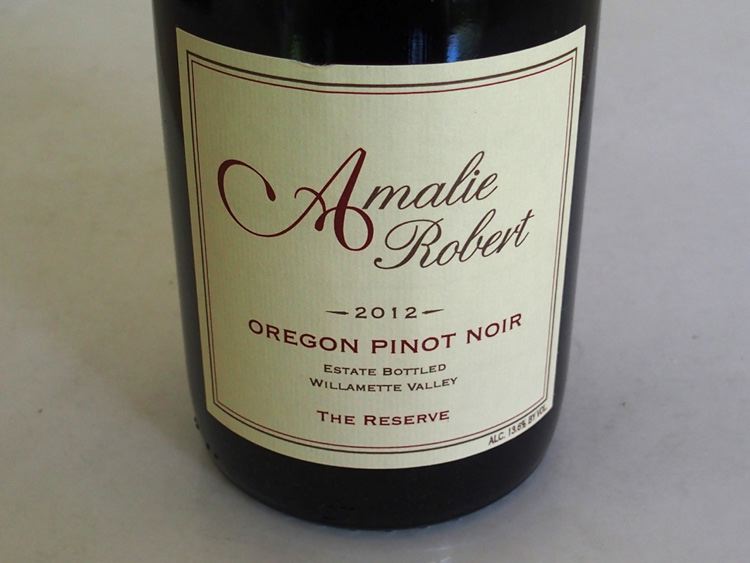 2012 Amalie Robert Estate The Reserve Willamette Valley Oregon Pinot Noir 13.6% alc., 65 cases, $100. The vintner’s favorite barrels of the vintage.Half Pommard and half Wädenswil clones. Whole cluster inclusion and fermentation with feral yeasts. Aged a minimum of 18 months in new oak barrels, a third of which was very tight-grained wood grown in Russia. · Moderately light reddish purple color in the glass. Exuberant aromas of cherry, wildflower, baking spice and nutty oak. The gorgeous core of black cherry fruit is blessed with supportive, age worthy firm tannins. Flavor notes of exotic spices, vanilla and nutty oak add interest. Long in the mouth and extremely long on the extraordinary finish. A serious, connoisseur's wine that needs time in the cellar for full enjoyment. Even better when tasted several hours later and the following day from a previously opened and re-corked bottle. Did I say the finish goes on and on? Score: 97
2011 Amalie Robert Estate The Uncarved Block Willamette Valley Oregon Pinot Noir 12.6% alc., 1,060 cases, $30. An introduction to Amalie Robert Pinot Noir. Estate grown and bottled. Represents all the clone and rootstock combinations of Pinot Noir grown in the estate vineyard. Fermented with whole clusters and feral yeast. Aged in French oak barrels for 12 months. Unfined and unfiltered. · Light cherry red color in the glass. Typical whole cluster infused nose with aromas of cherry, rose petal, pine sap and sandalwood. Light in weight, with flavors of red cherry, cranberry and baking spices framed by bright acidity and silky tannins. This wine reflects the very cool vintage admirably. Score: 90
2013 Amalie Robert Estate Heirloom Cameo Willamette Valley Oregon Chardonnay 12.9% alc, 86 cases, $50. Estate grown and bottled. Dijon clones 76 and 95. Whole cluster pressed and barrel fermented in a single 500 liter French oak puncheon without lees stirring. Full malolactic conversion. Aged on lees for 14 months then cold stabilized. A small amount of stainless steel fermented wine that did not under go malolactic fermentation was blended back into the wine before bottling. · Moderately light golden straw color in the glass. The nose is replete with aromas of lemon rind, apple and prickly pear. Both saline and earth charged, with primary flavors of lemon, pineapple, melon and subtle oak. Not a mainstream flavor profile and very individualistic, finishing with some length. Could be highly desirable or just unusual depending on your viewpoint, but in any case the wine is well composed. Score: 90
2013 Amalie Robert Pabuk’s Gift Late Harvest Botrytized Willamette Valley Oregon Chardonnay 10.2% alc., 52 cases, $50 (375 ml). Estate grown and bottled. At the end of September in 2012, extensive rains led to botrytis (noble rot) in the Chardonnay grapes particularly in one block. This rare event was caused by warm weather following typhoon Pabuk. The rains started the fungus infection, but the subsequent weather held it in check. Harvest Brix was 37.4º. About half Dijon clone 76 and half Dijon clone 95. · Moderately light cantaloupe color in the glass. Aromas of fig, ripe pineapple, honey and wax and a dead ringer for a French sauterne. Delicious flavors of dried apricot, honey, tropical fruits and fig spread. Somewhat viscous, not overtly sweet, sliding off the back of the palate like a silk sheet. The finish is notably adorned with intensity. A superb sweet wine with a story (read about it on the website) that makes it even more appealing. I do not drink much sweet wine and review even less, so a score would be superfluous. I would just say, I loved the wine.
Hyland VineyardI have written extensively about the mystery of the origin of the “Coury clone,” that was widely planted in the Willamette Valley in the 1970s using cuttings supplied by Charles Coury. Hyland Vineyard has the largest planting of own-rooted Coury clone Pinot Noir in the Willamette Valley, so when I received an invitation to visit, I eagerly accepted. Hyland Vineyard is planted on land that dates to the late 1840s when the land was initially part of the original Oregon Trail homestead claimed by Benjamin Hyland. A hundred and thirty years later, this land became the home of Hyland Vineyard when four families the Kreimeyers, Markleys, Welches and Trenhailes) teamed up in 1971 to plant Pinot Noir on the now 200-acre estate that has 180 acres under vine making it one of Oregon’s oldest and largest vineyards.
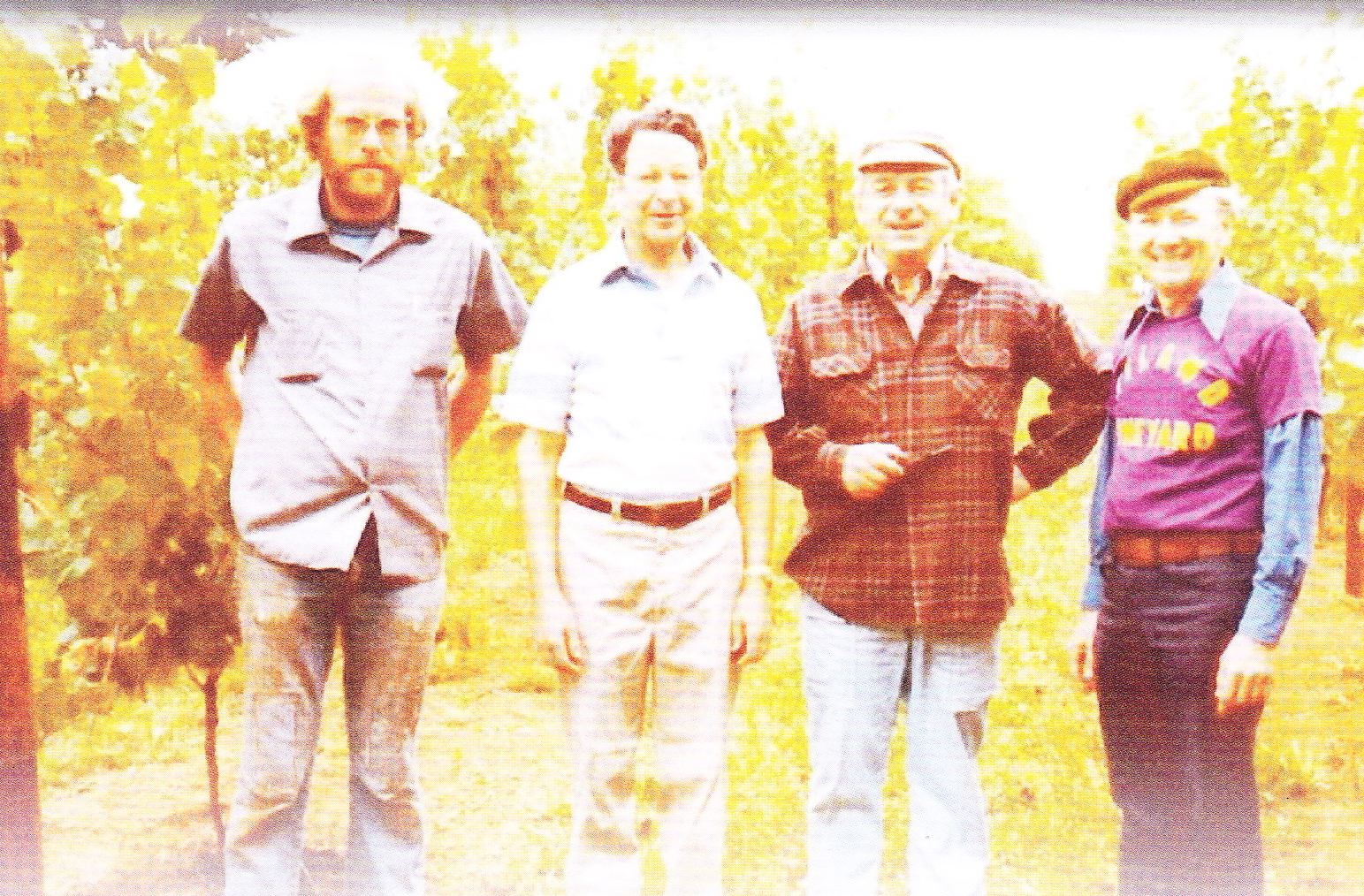 The land was chosen for wine grapes because of its temperate climate. Located at 600-850 feet elevation in the foothills of the Oregon Coastal Range, temperatures here tend to be cooler than in the rest of the Willamette Valley, making it ideal for Pinot Noir. Soils are uniformly Jory throughout the vineyard. The vineyard is located in the McMinnville AVA. The photo below shows the iron rich red Jory soils and the old Coury clone vines.
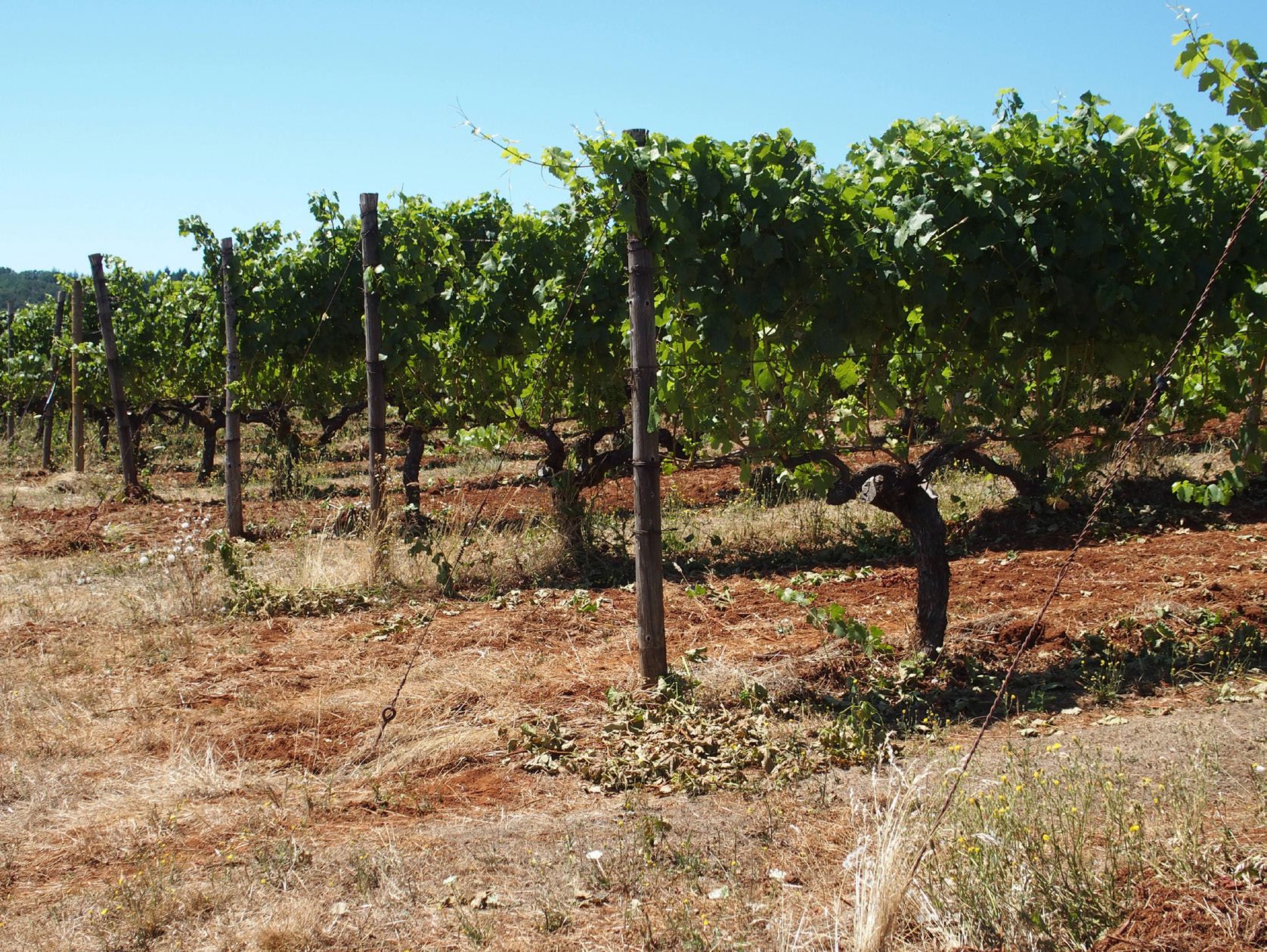 One-third of Hyland Vineyard is planted with the Coury clone, a suitcase selection said to have been smuggled into the United States by Charles Coury in his suitcase from Colmar, France, in the mid 1960s. For a detailed historical perspective, visit, www.princeofpinot.com/article/1214/, “Solving the Mystery of the “Coury Clone.” The photo below shows the small cluster size of Coury clone Pinot Noir, and the second photo shows a typical Cory clone vine.
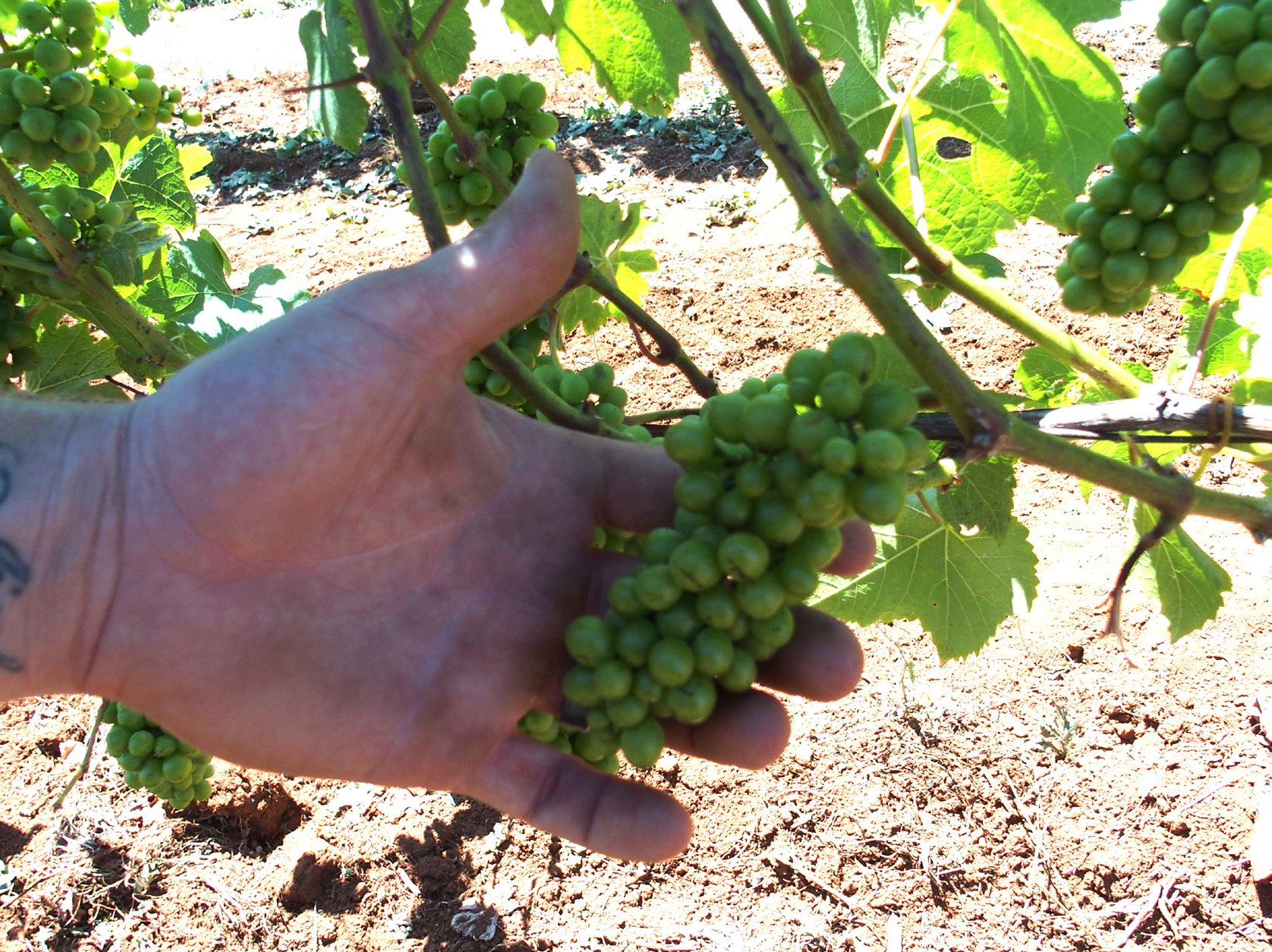
 For decades, many producers have crafted award-winning wines from Hyland Vineyard and bottled under their own labels. In 2007, Hyland Vineyard was bought by winemaker Laurent Montalieu and his spouse Danielle Andrus Montalieu in partnership with John Niemeyer. After the purchase, the vineyard was expanded to 200 acres. A majority of the fruit has been sold to Penner-Ash, Bergstrom and Beaux Freres wineries. In 2011, the first wines from Hyland Estates Winery were released, continuing the legacy that was started in 1971.
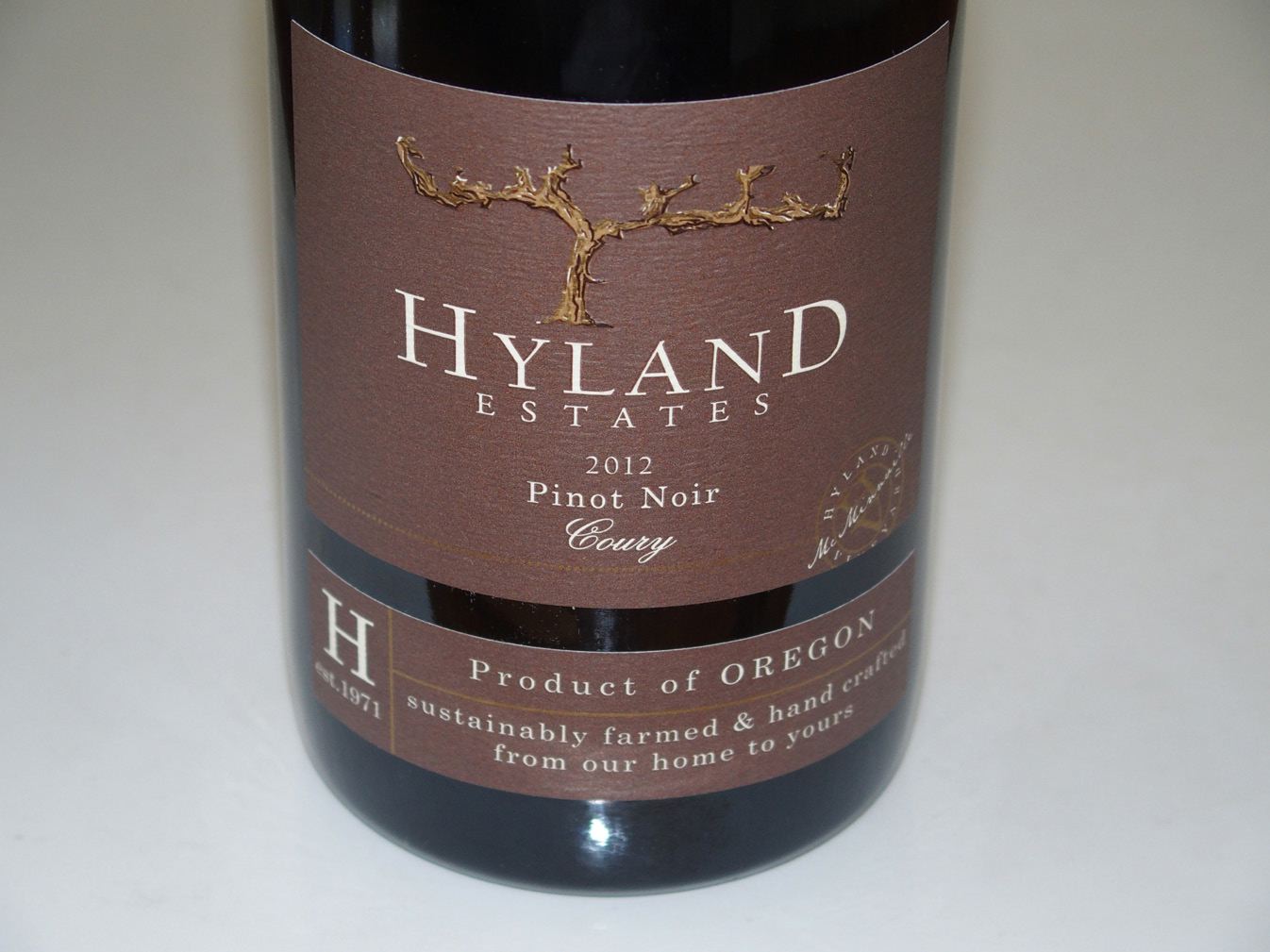 Besides the Coury clone, Pinot Noir clones planted at Hyland Vineyard include Pommard, Wädenswil, and Dijon 777, “828,” 113, 114, 667, and 115. The original Coury clone, Pommard and Wädenswil clones plantings are own-rooted, while newer plantings were added in 1989. Chardonnay plantings include 108 and Dijon 95, as well as a small amount of Riesling and Gewürtztraminer. A map of the vineyard is included below. Hyland Estates currently bottles all varieties grown in the vineyard. An Estate Pinot Noir, Coury Pinot Noir and Founder’s Selection Pinot Noir are produced. There are very few Oregon wineries that bottle a Coury clone designated Pinot Noir.
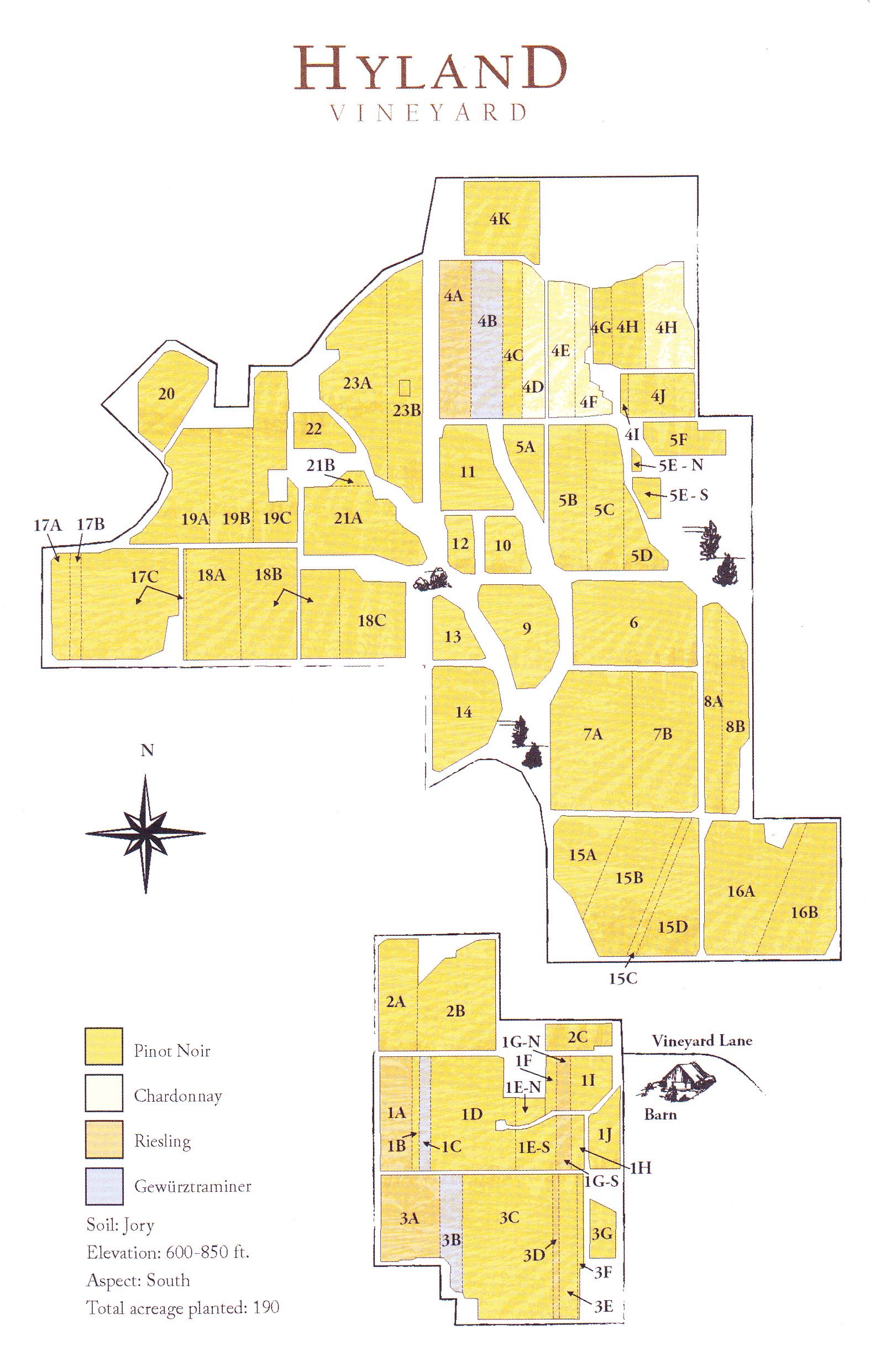 The wines, crafted by Laurent Montelieu, are outstanding. Tasting is available at the Hyland Estates Tasting Room located at 20980 NE Niederberger Rd, Dundee that is open daily from 10:00 a.m. to 5:00 p.m.. Visit www.hylandestates.com.
Pinot BriefsPinot Report Publisher Greg Walter Dies Greg Walter rose up through the ranks over 14 years in the early days of the Wine Spectator to become President of that publication, and later became a freelance writer. He launched a newsletter devoted to Pinot Noir, The Pinot Report, about the same time that I started The PinotFile. He was a devoted advocate of Pinot Noir and we crossed paths many times along the Pinot trail. Donations may be sent to his family at www.YouCaring.com. Skewis Wines 2014 Vintage is Swan Song Hank and Maggie Skewis, who founded Skewis Wines in 1994 dedicated solely to Pinot Noir, have decided to retire. The fall 2016 and spring 2017 releases from the 2014 vintage will be their last. Hank told his customers, “After 36 years of harvests, I must confess to feeling a little wistful as my first grape-free harvest begins. This was always an exciting time of the year for me, offering the opportunity and challenge of a a new batch of ‘raw material,’ and long days. I am very grateful to have been a part of the wine industry for so many years.” The tasting room in Healdsburg will remain open Friday-Sunday at least until the spring of next year. Visit www.skewiswines.com.
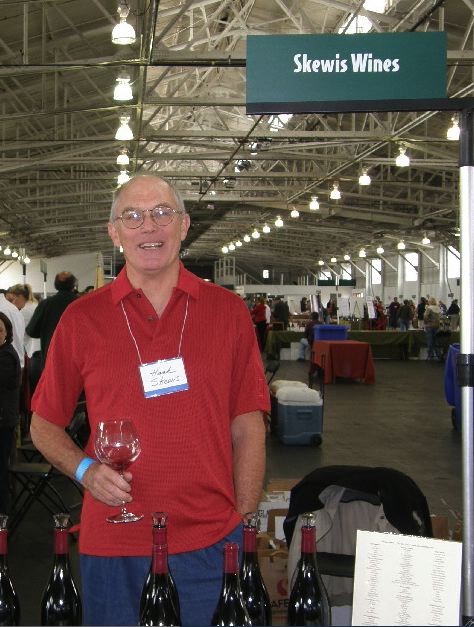 Ride the Rails with Kessler-Haak, Sanford and Zotovich Wineries This is an opportunity to taste Sta. Rita Hills wines, presented by the winemakers, as you roll down the rails along the Central Coast countryside. The tour departs from the Santa Barbara Amtrak station on Saturday, October 15, and returns late in the afternoon. A gourmet box lunch is included as you travel north to San Luis Obispo. The conveyance will be a 1949 Pullman club car Overland Trail. Seating is limited. Tickets are $148 per person. Order tickets at 805-680-0397. Pinot on the River The annual Russian River Valley Pinot on the River event will be held Sunday, October 23, on the Healdsburg Plaza. Over 70 artisanal Pinot Noir producers will be pouring beginning at 11:00 a.m.. Tickets are only $75 in advance. For tickets, visit www.pinotfestival.com/registration.html. 2016 Fort Ross-Seaview Wine & Harvest Festival The 4th Annual Fort Ross-Seaview Wine & Harvest Festival will be held on Saturday, October 15 at the site of the historic settlement that was the location where the first grapes were planted in Sonoma County in 1817. The event offers a delightful day of wine tasting, local food, crafts and music on the grounds of the Fort Ross State Historic Park on a bluff overlooking the Pacific Ocean. There will be a Pinot Noir seminar followed by a Grand Wine Tasting. Tickets for both Seminar and Grand Wine Tasting are $90 and are available at www.fortross-seaview.org/events/. Russian River Valley Single Vineyard Nights Winemakers and winegrowers will be pouring single vineyard wines from the Russian River Valley on Thursday, November 3, 2016, at The General’s Residence, Fort Mason, San Francisco, and on Thursday, November 10, 2016, at Library Galleria, 828 I Street, Sacramento. VIP tickets allow earlier entry and exclusive tastings of limited release and tasting room only wines. For tickets, visit www.rrvw.org/events/. Kosta Browne Raises $445,000 at Sonoma Harvest Wine Auction Co-founder of the Sonoma Harvest Wine Auction, Dan Kosta, served as Honorary Vintner Chair, as recognition for his leadership and commitment to Sonoma County’s wine and food community. Kosta Browne enlisted John Ash & Co., the restaurant where Dan Kosta and Michael Browne met, to host a special dinner for up to 50 attendees in celebration of Kosta Browne Winery’s 20th anniversary. Taking place at the winery on June 3, 2017, the special dinner will be paired with wines from the Kosta Browne library and each couple attending will take home a rare etched and hand painted 5-liter bottle of Kosta Browne single vineyard Pinot Noir. Bidding was oversold, with a total of 39 couples committing $5,000 each to attend the dinner. On top of the auction proceeds, Kosta Browne donated an additional $250,000 towards the “Fund the Future” initiative aimed at improving child literacy. The Sonoma Harvest Wine Auction held at Kenwood’s Chateau St. Jean raised a record $4.6 million. Ernie Loosen Decries High Alcohol Pinot Noir Ernie Loosen, a Mosel winemaker who also makes wine in Oregon as a joint venture with winemaker Jay Somers (J. Christopher Wines), was in Hong Kong and Macau recently. He said, “I believe New World Pinot Noir shouldn’t have high alcohol levels which can mask its subtle expression and upset ‘its balance and finesse.’ High alcohol doesn’t suit Pinot Noir. It just makes them fat and rich. Its okay for Cabernet Sauvignon, Shiraz or Grenache which can stand up to it but Pinot Noir needs that restraint and should let the soil speak for itself.” Loosen’s Oregon Pinot Noir is less than 13.0% and his Villa Wolf Pinot Noir is in the 12.5%-13.0% range. He went on to say, “It’s when you see a really overripe Pinot Noir at around 15% that you think, all that balance and focus has been lost, and it’s becoming a wine it doesn’t need to be.” Alcohol May Further Predispose to Heart Arrhythmia in Some Drinkers A study published September 14 in the Journal of the American Heart Association, looked at data on 5,220 subjects in the Framingham Heart Study. The participants’ average age was 56 with slightly more women than men. Regular drinking (the study did not look specifically at wine) appeared to increase a person’s risk for atrial fibrillation. Every 10 grams of alcohol consumed per day (equivalent to one drink a day), increased the risk of developing atrial fibrillation by about 5 percent. The researchers found that every additional drink of alcohol per day increased the size of the left atrium which is a predisposing factor for atrial fibrillation. The study did not prove cause and effect and it may be that some people have a genetic predisposition for atrial fibrillation and alcohol may add to that predisposition. People who have no heart risk factors such as high blood pressure or a family history of heart disease, and who exercise regularly, are not overweight and consume alcohol in moderation with meals, then a glass of wine a day is fine, even recommended by many doctors. That said, people who drink alcohol every day should discuss their personal risk with their doctor. Online Wine Reviews Frequently Used by Wine Buyers
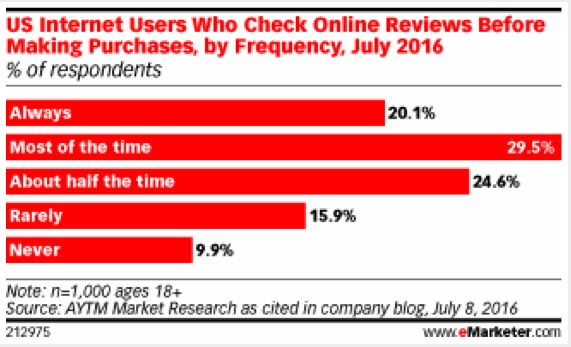
|